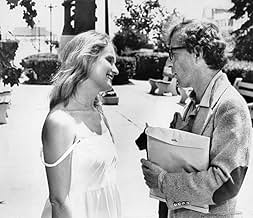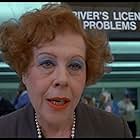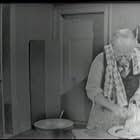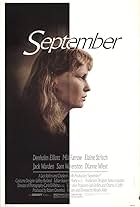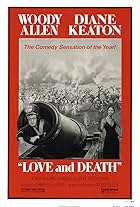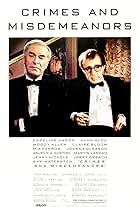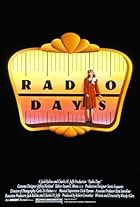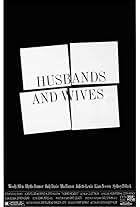VALUTAZIONE IMDb
7,2/10
24.283
LA TUA VALUTAZIONE
Durante una retrospettiva del suo lavoro, un regista rievoca la sua vita e i suoi amori: le ispirazioni per i suoi film.Durante una retrospettiva del suo lavoro, un regista rievoca la sua vita e i suoi amori: le ispirazioni per i suoi film.Durante una retrospettiva del suo lavoro, un regista rievoca la sua vita e i suoi amori: le ispirazioni per i suoi film.
- Regia
- Sceneggiatura
- Star
- Premi
- 2 candidature
Anne DeSalvo
- Sandy's Sister
- (as Anne De Salvo)
Trama
Lo sapevi?
- QuizWoody Allen has always strenuously denied that the film is autobiographical. Allen has said in the book "Woody Allen on Woody Allen: In Conversation with Stig Björkman" (1994): "[Critics] thought that the lead character was me. Not a fictional character but me. Not a fictional character but me, and that I was expressing hostility towards my audience. That was in no way the point of the film. It was about a character who is obviously having a sort of nervous breakdown and, in spite of success, has come to a point in his life where he is having a bad time".
- Citazioni
Sandy Bates: You can't control life. It doesn't wind up perfectly. Only-only art you can control. Art and masturbation. Two areas in which I am an absolute expert.
Recensione in evidenza
Funny, moving, imaginative, bold, intelligent, surreal, nostalgic and beautiful; Stardust Memories (1980) is one of Allen's greatest films, if not THE greatest. At its most simple level, the film is a merciless satire on the film industry, on the notion of celebrity, and on Allen's public persona, as he here essays the role of a stand-up comedian turned filmmaker wrestling with a number of weighty personal issues, including the death of a close friend, the breakup of a relationship and the beginning of an affair - all the while trying desperately to reconcile the need for personal success in relation to artistic expression. It is without question one of the filmmaker's most radical and imaginative works released at the peak of his powers, featuring a great deal of wit, warmth and human emotion alongside irreverent moments of personal homage, silliness and surrealism.
The film opens on a train as a ticking clock fills the soundtrack. Allen's character, Sandy Bates sits helpless in the carriage, surrounded by ugly, depressed looking people who stare back at him with dead eyes. As he looks out of the window he sees another carriage, this time filled with beautiful, revelling sophisticates all cheering and waving. Sandy tries desperately to convince the conductor to let him off the train so that he can switch carriages, but his pleas fall on deaf ears. As he tries frantically to signal to the other train, a beautiful woman kisses the glass and laughs as Sandy's train pulls away from the station. The next shot shows the ugly, depressed people from the train wandering through a garbage dump, recalling elements of The Seventh Seal (1957) and One Plus One (1968) before the film reaches the end of the reel and we realise that what we are seeing is a film within a film. The sequence works on a number of levels - firstly, as an extended homage to Fellini's 8 ½ (1963); establishing the theme of film-making and the games within the narrative, etc. Secondly, it is a comment on the nature of the character and on life itself; with none of the characters satisfied with the situations that they're in and always wanting something more. Lastly, the scene establishes the tone of the film; being every bit as stark, surreal and enigmatic as anything by Bergman, Fellini, Godard, etc - with the comment on mortality, on artist expression and on the journey of life - but is also incredibly funny.
Unlike later films of Allen that were more mature and more serious in-tone than the "early funny ones", like, for example, Crimes and Misdemeanours (1988) or Husbands and Wives (1992), Stardust Memory is a film rich in absurd humour, imagination, fun and frivolity, whilst also containing some of Allen's most moving and intelligent ideas. I'd liken it to a combination of the aforementioned 8 ½ and elements of the Coen Brothers' last definitive film The Man Who Wasn't There (2001), which would seem to have taken influence from certain elements depicted here. As a comment on the struggle of the filmmaker and the argument of art over commerce, Allen is entirely ruthless; turning the backroom nature of film production into a leering Fellini-like circus of stupidity, banality and contempt for the audience. At one point, Allen's character is being berated by the studio heads for turning in a film that is "pretentious, self-indulgent and unfunny", while carefully positioned in front of the famous Eddie Adams photograph of the execution of Vietcong prisoner Nguyễn Văn Lém; creating a tragic echo of that later scene which foreshadowed the murder of John Lennon.
It also shows the absurdity of film-making and the pressure for Sandy to return to former glories and produce work simply to satisfy the masses. Although Allen claims that there are no elements of auto-biography in his work, I think he is wrong. Even if does it unconsciously, without thinking, it's impossible to see Stardust Memories and not see it as a comment on the critical and commercial failure of his earlier film Interiors (1978). With that particular project, Allen was able to turn to the massive success of Annie Hall (1977) into producing a more sombre and serious film with heavy references to both Bergman and Chekhov. The film was a critical failure and led into the production of Manhattan (1979); one of Allen's most celebrated and iconic films, but one that he apparently wanted to have destroyed. Many of these personal issues can be seen in the character of Sandy, who is struggling through life like the rest of us and yet is expected to entertain. At one point he argues that it's impossible to be funny with so much sadness in the world, whilst simultaneously creating a film that is very funny as well as somewhat moving. The second element of the film deals with the memory of Sandy's troubled relationship with tortured manic depressive Dorrie. The relationship is sensitively handled and brilliantly performed by Charlotte Rampling, who conveys the fears, desired, dread and anxiety of this character on a path to self-destruction.
In the final act of the film the walls between life and death, fact and fiction, fantasy and memory all come tumbling down as Allen creates a kaleidoscope of elements all reoccurring from previous sequences in the film. The colourful characters, all chosen for their often unique physical features that are further distorted by the skewed, black and white cinematography of Gordon Willis also adds to the film's somewhat stark and surreal approach, which is filled with imaginative visual composition, intelligent production and location design, elements of wild fantasy and abstract, absurdist humour. By the end of the film, we no longer know if what we've experienced is real, literal or a theoretical film within a film, but we know the experience has been a unique one.
The film opens on a train as a ticking clock fills the soundtrack. Allen's character, Sandy Bates sits helpless in the carriage, surrounded by ugly, depressed looking people who stare back at him with dead eyes. As he looks out of the window he sees another carriage, this time filled with beautiful, revelling sophisticates all cheering and waving. Sandy tries desperately to convince the conductor to let him off the train so that he can switch carriages, but his pleas fall on deaf ears. As he tries frantically to signal to the other train, a beautiful woman kisses the glass and laughs as Sandy's train pulls away from the station. The next shot shows the ugly, depressed people from the train wandering through a garbage dump, recalling elements of The Seventh Seal (1957) and One Plus One (1968) before the film reaches the end of the reel and we realise that what we are seeing is a film within a film. The sequence works on a number of levels - firstly, as an extended homage to Fellini's 8 ½ (1963); establishing the theme of film-making and the games within the narrative, etc. Secondly, it is a comment on the nature of the character and on life itself; with none of the characters satisfied with the situations that they're in and always wanting something more. Lastly, the scene establishes the tone of the film; being every bit as stark, surreal and enigmatic as anything by Bergman, Fellini, Godard, etc - with the comment on mortality, on artist expression and on the journey of life - but is also incredibly funny.
Unlike later films of Allen that were more mature and more serious in-tone than the "early funny ones", like, for example, Crimes and Misdemeanours (1988) or Husbands and Wives (1992), Stardust Memory is a film rich in absurd humour, imagination, fun and frivolity, whilst also containing some of Allen's most moving and intelligent ideas. I'd liken it to a combination of the aforementioned 8 ½ and elements of the Coen Brothers' last definitive film The Man Who Wasn't There (2001), which would seem to have taken influence from certain elements depicted here. As a comment on the struggle of the filmmaker and the argument of art over commerce, Allen is entirely ruthless; turning the backroom nature of film production into a leering Fellini-like circus of stupidity, banality and contempt for the audience. At one point, Allen's character is being berated by the studio heads for turning in a film that is "pretentious, self-indulgent and unfunny", while carefully positioned in front of the famous Eddie Adams photograph of the execution of Vietcong prisoner Nguyễn Văn Lém; creating a tragic echo of that later scene which foreshadowed the murder of John Lennon.
It also shows the absurdity of film-making and the pressure for Sandy to return to former glories and produce work simply to satisfy the masses. Although Allen claims that there are no elements of auto-biography in his work, I think he is wrong. Even if does it unconsciously, without thinking, it's impossible to see Stardust Memories and not see it as a comment on the critical and commercial failure of his earlier film Interiors (1978). With that particular project, Allen was able to turn to the massive success of Annie Hall (1977) into producing a more sombre and serious film with heavy references to both Bergman and Chekhov. The film was a critical failure and led into the production of Manhattan (1979); one of Allen's most celebrated and iconic films, but one that he apparently wanted to have destroyed. Many of these personal issues can be seen in the character of Sandy, who is struggling through life like the rest of us and yet is expected to entertain. At one point he argues that it's impossible to be funny with so much sadness in the world, whilst simultaneously creating a film that is very funny as well as somewhat moving. The second element of the film deals with the memory of Sandy's troubled relationship with tortured manic depressive Dorrie. The relationship is sensitively handled and brilliantly performed by Charlotte Rampling, who conveys the fears, desired, dread and anxiety of this character on a path to self-destruction.
In the final act of the film the walls between life and death, fact and fiction, fantasy and memory all come tumbling down as Allen creates a kaleidoscope of elements all reoccurring from previous sequences in the film. The colourful characters, all chosen for their often unique physical features that are further distorted by the skewed, black and white cinematography of Gordon Willis also adds to the film's somewhat stark and surreal approach, which is filled with imaginative visual composition, intelligent production and location design, elements of wild fantasy and abstract, absurdist humour. By the end of the film, we no longer know if what we've experienced is real, literal or a theoretical film within a film, but we know the experience has been a unique one.
- ThreeSadTigers
- 8 giu 2008
- Permalink
I più visti
Accedi per valutare e creare un elenco di titoli salvati per ottenere consigli personalizzati
- How long is Stardust Memories?Powered by Alexa
Dettagli
- Data di uscita
- Paese di origine
- Lingue
- Celebre anche come
- Recuerdos
- Luoghi delle riprese
- The Great Auditorium, Ocean Grove, New Jersey, Stati Uniti(exterior of The Stardust Hotel)
- Aziende produttrici
- Vedi altri crediti dell’azienda su IMDbPro
Botteghino
- Budget
- 10.000.000 USD (previsto)
- Lordo Stati Uniti e Canada
- 10.389.003 USD
- Fine settimana di apertura Stati Uniti e Canada
- 326.779 USD
- 28 set 1980
- Lordo in tutto il mondo
- 10.389.003 USD
- Tempo di esecuzione1 ora 29 minuti
- Colore
- Mix di suoni
- Proporzioni
- 1.85 : 1
Contribuisci a questa pagina
Suggerisci una modifica o aggiungi i contenuti mancanti

Divario superiore
By what name was Stardust Memories (1980) officially released in Canada in French?
Rispondi




